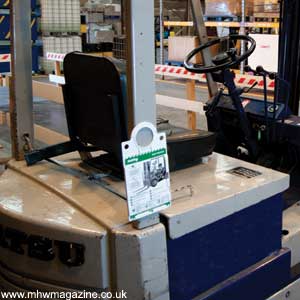
In the UK, four accidents involving fork lift trucks occur every day. Of these, more than one quarter result in hospitalisation or death. A lack of clear communication, training and regular maintenance are key factors in the number of accidents that involve forklift trucks.
Following a basic set of rules can help employers improve the safety of their employees and reduce the amount of accidents and injuries that occur when using forklift trucks. Scafftag, specialists in the management and communication of equipment status, outlines four key steps to follow to help reduce forklift truck accidents:
Step 1 - Risk assessment
Managers must complete a risk assessment of forklift truck operations to adequately control the risk and to ensure that safe systems of work and records are maintained, documenting and assessing all the hazards that each worker could potentially come into contact with. These should be completed, recorded and reviewed at suitable intervals. Such systems can include controls on use, defect reporting, recording, inspection and maintenance of forklift trucks and associated equipment. The type of hazards that workers could face are: the truck overturning (fork lift trucks can be unstable because of their small wheels), leakages from hydraulic fluid or batteries causing slips or burns from acid, fire/explosions from leaking gas and burns from hot surfaces such as the exhaust.
Step 2 - Identify when safe to use and when not to be used
Daily checks should be carried out before use to record whether the forklift truck is safe or unsafe to use. There are a variety of ways that workers can record the results of their daily checks such as entering the data into a register that is usually kept in the main office. The downside of this method is that often many workers visit the office before using the equipment, recording that the forklift truck is safe to use before they have carried out an inspection. Additionally, if there is a problem with the forklift truck and it is unsafe to use, there is no immediate warning system on the truck identifying that the equipment shouldn't be used. To help combat these issues and provide a simple, easy to understand system, daily check tags have been developed that are attached to each forklift truck, allowing you to not only record your assessment of the forklift but provide a clear diagram and description of the key areas to assess on your forklift. The front of the tag can also be removed to reveal a prohibition sign, clearly stating that the equipment is unsafe to use - simple, clear and effective.
Step 3 - Training
Managers must ensure they provide information, instruction, training, retraining and supervision to employees as necessary. Employees must have been adequately trained and licensed to drive the class or type of truck required for the job. Training should be theoretical, practical and verify operating ability relevant to the employees' job requirements. A suitably qualified instructor, licensed to carry out such training, must conduct all training. Although it is not outlined in the HSE guidance, many training specialists suggest that refresher training is carried out every 3 years especially if new equipment or systems of working have been introduced or if operators only use the equipment occasionally.
Step 4 - Maintenance
As well as daily checks, regular maintenance of forklift trucks should be carried out in accordance with the manufacturer's recommendations. Intervals between inspections will vary depending on the working environment and how often the equipment is used. It is a legal requirement that a Thorough Examination is carried out on fork lift trucks at least once a year to ensure that the equipment is safe to use. Not carrying out these regular inspections can lead to long periods of down time if the vehicle requires extensive repairs, costing the company money every day that the equipment is out of use.
For more information about Scafftag and its range of products please visit www.scafftag.co.uk